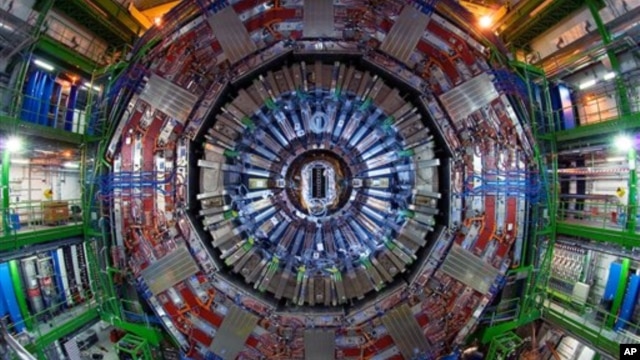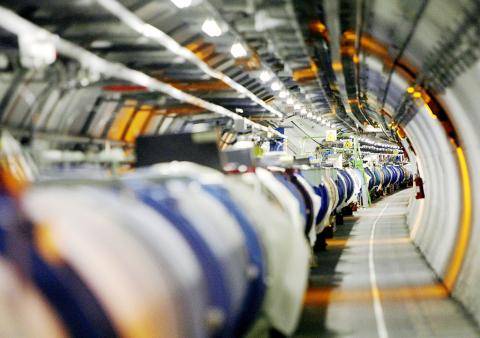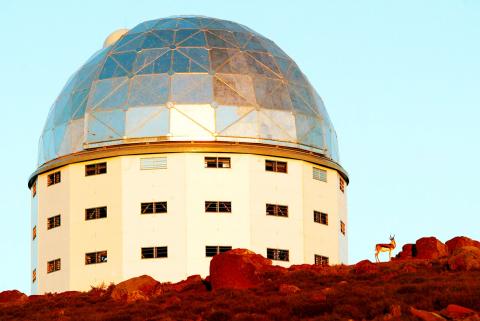Large Hadron Collider down for 2 months - CNN.com
states the collider was more damaged than orginally believed.
states the collider was more damaged than orginally believed.
Follow along with the video below to see how to install our site as a web app on your home screen.

Note: This feature currently requires accessing the site using the built-in Safari browser.
The Higgs boson particle explains why other particles have mass, but it has not yet been observed by physicists. The LHC is housed in a 27km-long tunnel under the French-Swiss border. It smashes together proton particles travelling at close to the speed of light in a bid to uncover secrets of the Universe. According to Professor Tom LeCompte of the Argonne National Laboratory, US, who works at the LHC: "The most likely place for the Higgs to be is in a very good place for us to discover it in the next two years."
The LHC has now restarted after its winter shut down - and is about to embark on a run of work that could make or break the current view of how the Universe was formed. The most widely accepted theory of particle physics requires the existence of the Higgs - and the detection of this particle is one of the LHC's main objectives. If the collider does not detect the Higgs within two years, researchers say they will know that it does not exist - at least in the form required by the Standard Model, the framework which was devised to explain the behaviour of fundamental particles.
"The Higgs is one model of many," according to Professor LeCompte. "It's a model that we like. It's simple, its elegant, but it's entirely possible that there is something else beyond the Higgs that does its job instead, and what we may discover is instead of the Higgs itself we may discover something much more interesting. "There could be multiple Higgses or there could be something completely different doing the same job as the Higgs in a completely different way."
But he adds that not finding the Higgs may be more exciting than finding it - because researchers may have to modify their current view of sub-atomic physics. "If we don't see it after this two year run it means that something is perhaps not the way that we think it is, either the Higgs search itself had to be amended in some way or some of its indirect evidence may be pointing us in the wrong direction," said Professor LeCompte.
BBC News - LHC 'has two years to find Higgs'


A particle accelerator in the US has shown compelling hints of a never-before-seen particle, researchers say. The find must be more fully confirmed, but researchers at the Tevatron are racing to work through existing data. If proved, it will be a completely new, unanticipated particle; researchers say it cannot be the much sought-after Higgs boson.
It could also signal a new fundamental force of nature, and the most radical change in physics for decades. Researchers at the Tevatron formally announced the find on the collaboration's website, after posting an as-yet unreviewed account of the research on the Arxiv repository. The team was analysing data from collisions between protons and their anti-matter counterparts antiprotons. In these collisions, particles known as W bosons are produced, along with a pair of "jets" of other particles.
It was in these jets that the unexpected "bump" in the team's data came to light, potentially representing a particle that the current understanding of the zoo of subatomic particles - the Standard Model - does not include. "When you look at the data it's not some disagreement with the Standard Model, it's a nicely formed bump in the distribution that looks really like the kind of bump you'd get if a new particle was being exchanged in this process," said Dan Hooper, a theoretical physicist at Fermilab who was not involved in the research.
'Time will tell'


For 2012, their top pick was the long-anticipated confirmation of the existence of the so-called "God particle," which is believed to be a building block of the universe.
Science breakthough of 2012
The confirmation of the existence of a sub-atomic particle known as the Higgs boson was named breakthrough of the year by the prestigious Science magazine. The long-sought-after particle - believed to impart mass to all other matter in the universe - was made by researchers at the CERN particle physics lab near Geneva, using the $5.5 billion atom smasher called the Large Hadron Collider. In a podcast interview on the magazine’s website, Science deputy news editor Robert Coontz said the discovery fills an important gap in our understanding of the physical structure of the universe. “The Higgs boson is a fundamental particle that completes physicists’ standard model, which describes all the fundamental particles and the forces with which they interact.”

Researchers at the CERN physics lab near Geneva, used the $5.5 billion atom smasher, called the Large Hadron Collider, to confirm the existence of the Higgs boson particle.
Coontz said the discovery, first hypothesized by physicist Peter Higgs 40 years ago, may spark a new round of discoveries in particle physics. “That’s what the scientists at CERN are going to be looking for," he said, "that beyond the standard model lies this theory; one of them is called ‘super symmetry’ in which every particle in the standard model has another particle that hasn’t been discovered yet.”
Matter and anti-matter
Another major breakthrough listed by Science was further proving the existence of so-called anti-matter particles which annihilate themselves. These elusive, short-lived particles may have practical applications in information technology, and the development of the so-called quantum computer. “Computers that are based on things called qubits instead of bits," Coontz said. "So, it could well be that these will turn out to be the key to these super-duper computers unlike anything else we have, and that will be a breakthrough of the year, if it happens. This year all they’ve got is quasi particles that have these properties.” Quantum computers would be vastly more efficient at storing and processing data than today’s silicon-chip computers, according to Coontz.
Denisovan genome
In the 1960s, Prof Higgs and other physicists proposed a mechanism to explain why the most basic building blocks of the Universe have mass. The mechanism predicts the existence of a Higgs particle, the discovery of which was claimed this year at the Large Hadron Collider. Prof Higgs has been made a Companion of Honour. The recognition confers no title but is restricted to a select group of 65 for achievements in the arts, literature, music, science, politics, industry, or religion.
His discovery announced in July this year of a particle consistent with the Higgs boson immediately led to calls for the 83-year-old to be knighted. He is now also considered to be a candidate for a Nobel prize, perhaps in conjunction with other physicists who reached similar conclusions at the same time. Born in Newcastle upon Tyne, Higgs was inspired at school by the work of physicist Paul Dirac, who helped lay the foundations of quantum mechanics and predicted the existence of antimatter.
After obtaining his PhD from King's College London, he held academic positions at the University of Edinburgh and then London before returning to the Edinburgh to lecture at the Tait Institute of Mathematical Physics. According to one popular version of the story, Prof Higgs came up with the concept during a walk in the Cairngorms. But in an interview earlier this year, he told BBC News that there was no "eureka moment".
Best explanation of Higgs boson?

With the reopening of its $10 billion proton collider in early 2015, the stage will be set for observing more rare phenomena - and unlocking more mysteries, said James Gillies, chief spokesman for the European particle physics laboratory known as CERN. The Large Hadron Collider under the Swiss-French border will operate for two more months then shut down through 2014, allowing engineers to lay thousands more superconducting cables aimed at bringing the machine up to "full design energy," Gillies told The Associated Press on Friday.
Physicists at the European Center for Nuclear Research, known by its French acronym CERN, won't exactly be idle as the collider takes a break. There are still reams more data to sift through since the July discovery of a new subatomic particle called the Higgs boson - dubbed the "God particle - which promises a new realm of understanding of the universe.
For the next two months, the Large Hadron Collider will be smashing protons with lead ions, then undergo several weeks of testing before it shuts down. The collider launched in September 2008, but had to be switched off just nine days later when a badly soldered electrical splice overheated, causing extensive damage to the massive magnets and other parts of the collider some 300 feet (100 meters) below the ground. It cost $40 million to repair and improve the machine. Since its restart in November 2009, the collider has performed almost flawlessly and the power produced has been ramped up to ever-new record levels, creating a treasure trove of new data to sift through.
But because of the 2008 accident, the collider could only run at an energy level far below what it was designed to do. To fix that, Gillies said, engineers over the next two years will install 10,000 redesigned superconducting cables that connect between the magnets. That will vastly improve its capacity to simulate the moments after the Big Bang nearly 14 billion years ago. "It will bring you more collisions. Which means that the more collisions you have, the more likely you are to see rare events," he said. "The Higgs particle was just one of many on the wish list that we'd like to find, so higher energy increases your discovery potential."
Source
The collider suffered a “severe electrical perturbation” at 5:30am on Friday, the European Organization for Nuclear Research (CERN) said in its daily summary of activity at the giant laboratory straddling the French-Swiss border. It said the cause was a “short circuit caused by fouine [weasel],” on a 66-kilovolt transformer, adding that its connections sustained some damage. CERN spokesman Arnaud Marsollier told the BBC it would take a few days to repair the damage caused by the weasel, which did not survive its high-voltage encounter. “Not the best week for LHC!” CERN said in its summary.

The Large Hadron Collider is pictured in the European Particle Physics Laboratory near Geneva, Switzerland
Experiments at the collider are aimed at unlocking clues about how the universe came into existence by studying fundamental particles, the building blocks of all matter and the forces that control them. The Large Hadron Collider, housed in a 27km tunnel, was used to prove the existence of the Higgs boson, also known as the “God particle,” which confers mass. That discovery earned the 2013 Nobel Prize in Physics for two of the scientists who had theorized the existence of the Higgs back in 1964.
The Large Hadron Collider allows beams containing billions of protons to shoot through the massive collider in opposite directions. Powerful magnets bend the beams so that they collide at points around the track where four laboratories have batteries of sensors to monitor the smashups. The sub-atomic rubble is then scrutinized for novel particles and the forces that hold them together.
Weasel goes pop as Large Hadron Collider shuts down - Taipei Times
Quick reaction times, as well as being significantly cheaper than similar European or US facilities, in producing the science are key competitive advantages, a senior astronomer at the SALT consortium told reporters. “SALT is now living up to expectations, producing high-quality science data that probe the far reaches of the universe,” South African Astronomical Observatory director Ted Williams said. Scientists know of neutron stars, large objects about the size of the sun that have compacted down at the end of their lives to something about 10km across, the last stop before a black hole.
Williams said these incredibly dense objects have been known for decades to produce pulsars, which emit regular pulses of radio waves and other electromagnetic radiation at rates of up to one thousand pulses per second. “But there is another class of compact objects called white dwarfs, bigger, the size of the Earth. So rather than 10km in size we are looking at 6,000km and we’ve just discovered the very first white dwarf pulsar,” he said of the previously unknown celestial phenomenon.

A springbok stands beside the building housing the Southern African Large Telescope (SALT), near Sutherland, South Africa
Situated atop a hill in South Africa’s Northern Cape about 350km north of Cape Town, the US$43 million SALT telescope used its powerful spectroscopy light measurement tool to prove the existence of the white dwarf pulsar. Shared by a consortium of partners from South Africa, India, America and Europe, SALT’s queuing system allows it to interrupt routine observations and within minutes focus its 10m optical telescope on new discoveries, Williams said. In February, SALT was the first major telescope to take a spectrum of a supernova in the nearby Centaurus A galaxy hours after its discovery.
It also helped reveal one of the biggest explosions ever recorded in the universe, 200 times more powerful than a typical supernova and believed to have shone at 570 billion times the brightness of the sun. “It is what we wanted for South Africa and for Africa, not to stay at the margins but actually at the center and beginning to do world-class quality work,” said South African Minister of Science and Technology Naledi Pandor, who visited the telescope on Friday. Together with Australia, South Africa is also co-hosting the world’s biggest and most advanced radio telescope, the US$2 billion Square Kilometre Array, which is to study the origins of the universe and help probe for extraterrestrial life.
Africa’s SALT co-discovers white pulsar - Taipei Times